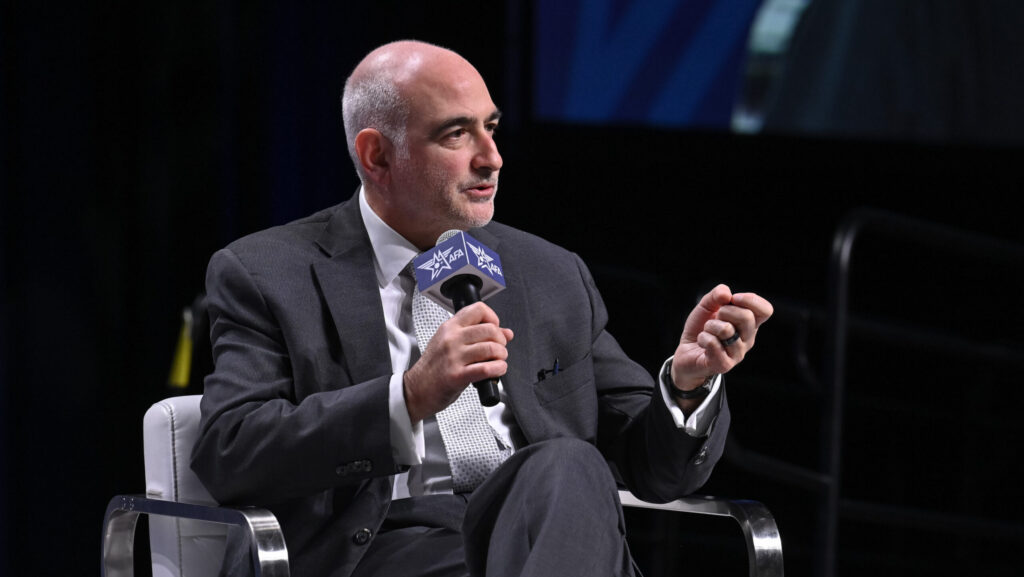
Assistant Secretary of the Air Force for Space Acquisition and Integration Frank Calvelli speaks during the panel discussion “Driving Change with Speed” with Assistant Secretary of the Air Force for Financial Management and Comptroller Kristyn Jones, performing the duties of the undersecretary of the Air Force, and Assistant Secretary of the Air Force for Acquisition, Technology and Logistics Andrew Hunter at the Air and Space Forces Association 2024 Warfare Symposium in Aurora, Colo., Feb. 13, 2024. (U.S. Air Force photo by Eric Dietrich)
WASHINGTON — Frank Calvelli was appointed as the Pentagon’s first-ever senior acquisition executive in charge of military space programs — a position first mandated by Congress in the 2020 National Defense Authorization Act — on May 5, 2022.
As Air Force assistant secretary for acquisition and integration, he has been responsible for all Space Force-related spending, which came to approximately $20 billion last year when one combines the activities of Space Systems Command, the Space Development Agency (SDA) and the Space Rapid Capabilities Office (SpRCO).
In an exclusive exit interview, Calvelli discussed his legacy, including his nine tenets, lessons learned and advice on acquisition reform to his successor and the Defense Department writ large.
He said that while he is proud of the success so far by SDA in showing the Space Force the way on speeding satellite development, he also is urging his successors to judge programs not just on accelerating schedules but providing results for the warfighter. Also, keep in mind that in the acquisition process, he said, “industry lies.” The following has been edited for clarity and brevity.
BREAKING DEFENSE: What are you most proud of from your time here?
CALVELLI: I think establishing a culture of project management discipline. And what I mean by that is we really put an emphasis on on understanding our programs and overseeing them properly. We did an emphasis on delivering on cost and schedule; … the ninth tenet, which was execution, is the most important one. We started doing quarterly program reviews with the program executive officers and reviewing cost, schedule, performance of all the portfolio. … And we started doing bi-weekly tag ups with each PEO walking through the status of programs.
What is your biggest regret?
OCX [Next Generation Operational Control System] is still not in ops.
MORE: Calvelli’s biggest regret: New GPS ground system still non-operational
From what I can tell, there’s been kind of a whole revamp of ground systems, trying to reorganize how they’re being developed and/or integrated. Could you talk a little bit about that?
There’s a real diverse set of [acquisition] strategies out there for ground right now. And you know, we know the one-size, big bang approach of a giant, monolithic ground system, with one vendor … typically doesn’t work. We’ve experienced that across government for decades.
If you look across the board, a lot of experimentation is going on. You know, there’s contracts that have large amounts of ID/IQs [indefinite delivery/indefinite quantity awards] that are doing task orders and the government acts as an integrator. There’s ground pieces where, like the Evolved Strategic SATCOM or even on FORGE [Future Operationally Resilient Ground Evolution] which is doing missile warning, where they’ve broken it up into decent sized pieces … three to five elements, as opposed to having a monolithic ground [system].
I really give a lot of credit to SSC and SpRCO and SDA and others who are trying new approaches to ground that are other than this giant, ‘let’s go hand a billion dollar contract to a big prime’ [approach]. But I think the jury still out as to which approach will work the best.
You were successful in getting the Contractor Responsibility Watch List (CRWL) program elevated to the level of your office in the 2025 National Defense Authorization Act. What do you think is going to happen with that? And what are your hopes for that?
I’m big fan of the CRWL. It started at the NRO [National Reconnaissance Office, where Calvelli spent much of his career]. It just something the NRO did on its own. It wasn’t any kind of law, and they use it quite effectively. I don’t know what’s gonna happen with it.
It was implemented the first time last year by SSC, and it’s been on the books since 2018, right?
I’m very fortunate to have had [Gen.] Mike Guetlein as a leader at SSC, who is a great partner, and Mike worked that hard. I honestly don’t know what’s gonna happen with it. I hope they use it effectively. I think it’s an amazing tool to have. I think other organizations have used it effectively. I hope that the Space Force and the Air Force continue [to use it].
Has the company that’s on it come off yet?
[Big sigh and eye roll.] Still on.
There is a Space Force issue with NRO, and that’s the understaffing issue that has been raised on the Hill. Is that an issue that can be perhaps resolved, given that the Space Force is small, by spreading the burden?
I hope it gets worked positively, because I think that the NRO is an amazing training ground for our folks. What I have found is that officers and even civilians that go out there and do three or four years of the NRO come back with some really great habits on project management. And they’re much stronger project managers by spending that time at the NRO.
As you know, program management and acquisition itself is not easy. If it was easy, the Department of Defense would not have such a poor track record. Any opportunity we get to get folks at the NRO to get that kind of experience and expertise on acquisition … I think is only going to help the Space Force in the future.
Are you happy with the where the Space Force is with acquisition training? There has been some concern expressed about that on the Hill.
The issues that bother me more are not just Space Force-related. It’s just the experience base across the whole Department of Defense. … What makes a really good acquisition professional especially on the satellite side of the house is experience and and time. What I’ve seen is that we send folks for a lot of training, but then they may not necessarily get the experience or time on station to actually take advantage of that, unlike the NRO, where we leave people in place for large periods of time, like many many years.
The Department of Defense has a whole different culture, where every two years to three years you move people. And I think when you do that, no matter how smart the person is or how good they are, you just really don’t have that much time in the seat to get the experience that you need.
The big push I had for ‘build smaller systems’ was tied to that. Because when you take somebody and you put them on a program that’s gonna be seven years, you gotta expect there’s gonna be a high turnover and then what you lose is ownership. … What I really want is total ownership, the whole experience through. When you start building stuff like that, take three years to go a smallsat, then it’s a lot easier to get somebody to be in the job three years from the beginning to the end.
If you had a magic wand, what one thing would you do with it?
Send my wife and me to the beach? I don’t know, I guess I would deliver all programs on cost and schedule. Every time we overrun a program we just rob our future. Overruns are like the worst thing we could possibly do, and it all comes down to getting the program up front right. I’m not sure we spend as much time as we should making sure that that RFP [request for proposals], those statements of work and that source selection is going to lead to an executable program. I think we need to get better at assessing schedule and cost realism as part of source selection evaluation.
We have to avoid Taco Bell Syndrome. [Note bene: Where despite lack of contractor expertise, the cheapest bid wins]. I think, on any cost plus contract that we do, industry lies, okay? I mean, they do, they lie. It’s a known fact at least, I grew up at the NRO knowing that fact. I’m not quite sure the Space Force knows that fact yet. Or the Department of Defense. They seem to trust industry more than they probably should.
Is there anything I should have asked but didn’t or that you want to tell me?
Something I may have missed and I think is important: I have been a staunch advocate and supporter of SDA. I protected them as they transitioned into the Department of the Air Force, and over the last few years made sure they kept all their authorities and delegations. Proliferated small satellites for many mission areas, that can be built rapidly is without a doubt the way to go, and SDA is showing that direction.
However, the big test comes this spring as Tranche 1 starts to launch. It will be critical that these satellites are initialized quickly, work, and then actually get used by operations (i.e. the Joint Force).
It doesn’t matter how fast we build them if no one uses them.
The Tranche 1 launches this spring will be the make or break moment for the Space Development Agency. If Tranche 1 launches, the satellites work as designed, and the capabilities are used by the operational community, then it’s a success. If not, the issue will not be the use of small satellites, but something with the SDA acquisition approach that will need to be reassessed.





